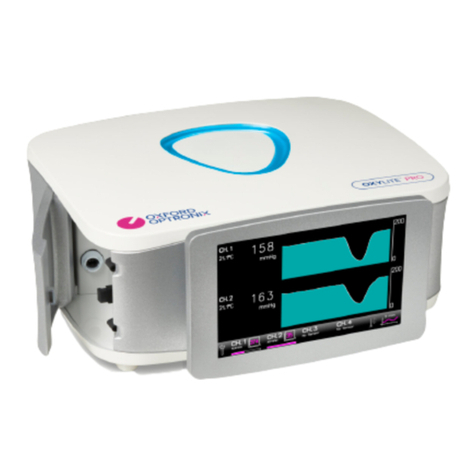2. INTRODUCTION
2.1 General Description
The OxyLite is an instrument capable of continuous, quantitative
measurement of the partial pressure of oxygen (pO2) and temperature in
tissues, physiological fluids, cell cultures and other in vitro applications. pO2
is also variously referred to as an ‘oxygen tension’ or as ‘dissolved oxygen’.
OxyLite is an optical device based upon the principle that the presence of
molecular dissolved oxygen in tissues or fluids can terminate (quench) light
emitted by a fluorescent compound (dye). The quenching of the fluorescent
light is proportional to the pO2in the vicinity of the dye.
The OxyLite system consists of a portable monitor and detachable, re-
usable sensors. The monitor houses a green LED light source, sensitive
photo-detector, a PC module and proprietary signal processing electronics.
All OxyLite sensors comprise a single optical fibre that conducts light from
the monitor to the sensing tip. The sensing tip contains a platinum-based
fluorescent dye held within a polymer matrix.
When the dye is illuminated/excited with light from the monitor, it fluoresces.
The fluorescent light is returned to the monitor using the same optical fibre
and the signal processor determines the fluorescent decay time. From this,
the corresponding pO2is derived. As pO2in the vicinity of the sensing tip
decreases, the extent of quenching decreases and the fluorescence decay
time increases. The quenching process is a purely collisional dynamic where
the energy from the excited fluorescent dye is transferred to the oxygen
molecule during a collision, hence, reducing the emission intensity as well
as the fluorescent lifetime of the dye. Thus, the oxygen content of the tissue
or fluid under investigation is not changed by the measurement process.
Measured pO2is displayed on the monitor’s display in units of either
millimetres of mercury (mmHg) or kilo Pascal (kPa).
Measured pO2is dependent on the local temperature at the sensing tip. In
general it is therefore important that pO2measurements are compensated
for temperature. To this end, the OxyLite monitor incorporates a calibrated
temperature measurement system. The OxyLite monitor performs automatic
temperature compensation and will generate a continuous readout of
temperature when a combined oxygen/temperature sensor is in use.
In order to display an accurate pO2value the OxyLite requires calibration
data. The calibration data is sensor-specific and for maximum ease of use
each sensor is supplied pre-calibrated. The calibration data, as well as setup
information are contained in a miniature ‘EEPROM’ electronic chip integral




























